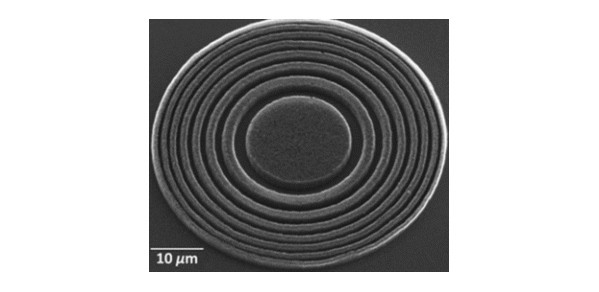
Tim Wilkinson and colleagues have created arrays of carbon nanotube Fresnel lenses, each 77 micrometers in diameter and with fifteen zones. These lenses have exceptional optical properties, with high contrast and efficient focusing.
The first Fresnel lens was installed in 1823 in the Cordouan lighthouse, where its beam was visible for 32 km. Since then, this lens design has been used in lighthouses, traffic lights, automobile headlights, magnifying glasses, cameras, and more. Compared to a conventional lens design of comparable aperture and focal length, a Fresnel lens requires less mass and volume, allowing it to be thinner and flatter, capturing more oblique light from a light source.
Reflections from the opaque zones in a Fresnel lens can degrade the focusing and lensing properties, however. Tim Wilkinson and colleagues Ranjith Rajasekharan, Haider Butt, Qing Dai and Gehan Amaratunga, at the Department of Engineering overcame this limitation by using the darkest man-made material ever — low-density, vertically aligned carbon nanotube arrays.
Tim and his colleagues created arrays of carbon nanotube Fresnel lenses, each 77 micrometers in diameter and with fifteen zones. These lenses have exceptional optical properties, with high contrast and efficient focusing.
Their findings are published in an article in the journal Advanced Optical Materials, Volume 24, Issue 23, dedicated to breakthrough discoveries and fundamental research in the field of light-matter interactions. It includes communications, full papers, and reviews.
The authors say these fabricated carbon nanotube Fresnel lenses offer new possibilities in designing highly flexible and efficient interconnection networks with massive parallelism. Potential applications include efficient focusing, deflecting and collimating tasks in optical sensor systems, optical computers, optical data transfer, optical communication, and even integration into 2D source arrays for neural network architectures.

